When converting your campervan or motorhome, choosing the right toilet is a crucial decision. From space-saving designs to off-grid solutions, we'll explore various campervan toilet options and weigh the pros and cons of each.
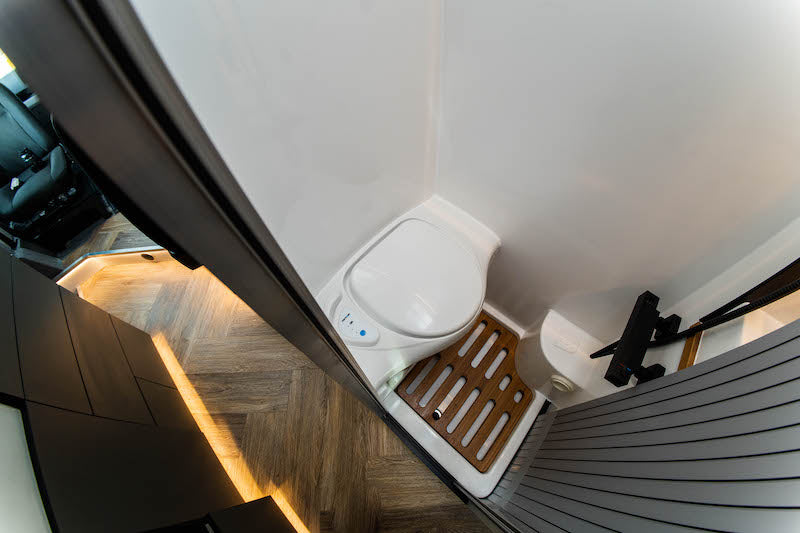
Although not an enjoyable subject to discuss, the toilet is a very important part of any conversion. Giving some thought to how you’re going to dispose of the waste when on trips is important. Many people don’t realise there are a few different options available. We’ve included all options that would work in a larger campervan conversion like a Crafter or MAN.
Finding the right toilet involves some compromise since there's no one-size-fits-all solution, but certain options might be a better fit for different people.
Cassette Toilet
A Cassette Toilet, like Thetford or similar, is a compact sanitation solution designed for motorhomes and campervans. This toilet system consists of two main components: a toilet bowl and a removable waste-holding tank, known as the cassette.
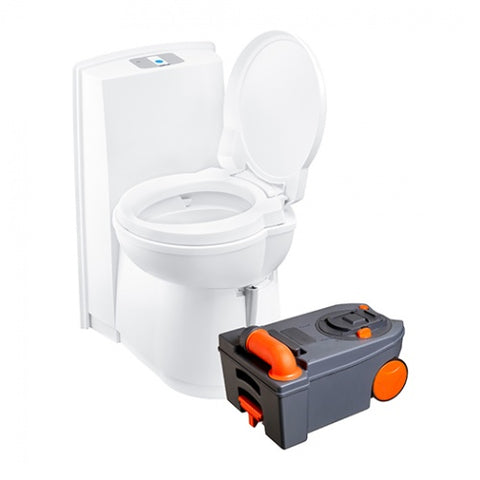
The toilet operates by using a small amount of water to flush waste into the cassette, which can be easily detached and emptied at designated disposal sites. Cassette toilets are the most common toilet type in motorhome conversions. You add green or blue chemical to the system to stop smells.
Pros
- Easy Maintenance: Simple to empty and clean
- Water Independence: No need for lots of water
- Size: Can fit into small wetrooms or bathrooms
- Tiny amount of electricity required for the tank level indicator
Cons
- Limited Capacity: Requires frequent emptying
- You can only empty the tank at certain disposal points
- Can be a smelly job to empty the tank
- Can be heavy to carry when full
- Not for Full-Time Use: Best suited for occasional use
- Maintenance: Regular care for the cassette tank is essential
- Uses chemicals to stop the smell - bad for the environment
Composting Toilet
Composting toilets are eco-friendly alternatives that work by converting human waste into compost. These toilets utilise a natural decomposition process to break down organic matter.
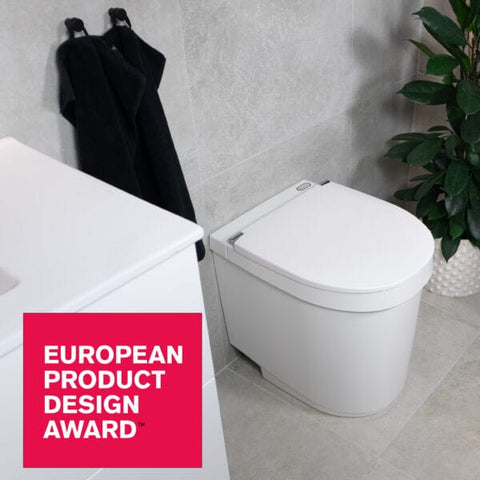
Over time, the waste transforms into nutrient-rich compost that can be safely and hygienically disposed of or used as fertiliser. Composting toilets are waterless and do not require a connection to traditional sewage systems, making them a sustainable and off-grid-friendly option.
Modern composting toilets, like Separate or Simploo, are becoming more popular. These work by separating the liquid and solid waste. By separating the waste it prevents “sewage” which means there is little to no smell. In your campervan you would have a small 12v fan fitted which draws out any smells to the outside.
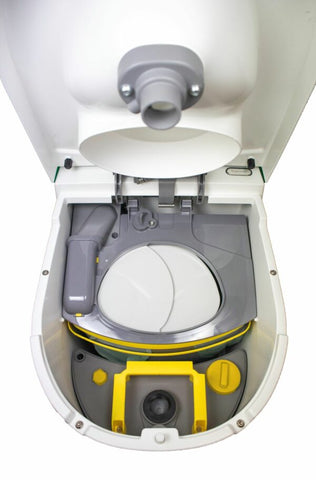
While the idea of composting toilets might seem unpalatable, it actually provides a very modern solution to an age old problem!
Pros
- Eco-Friendly: Waste turns into compost
- Water Efficiency: No need for water
- Versatility: Suitable for remote locations without plumbing
- Compact Design: Perfect for small spaces
- User-Friendly: Simple operation
- Waterless: No plumbing or water connection needed
- Can be disposed of at elsan points if no compost site avalible
- Tiny amount of electricty required for 12v fan
- Modern looking toilet system that will fit in motorhome bathroom
- Good for long term or high use
Cons
- Learning Curve: Users may need time to adjust
- Perception: Some users may find composting toilets unconventional
- Liquids container requires more frequent emptying
- May require more attention or thought that cassette toilet
Vacuum Toilet
There are a few Vacuum toilets on the market. We will be focusing on the C1 toilet from Clesana. It is distinctive because it operates without water. After using the toilet, a fan creates increased air pressure, causing the waste to compress into a bag. This compressed waste is then sealed at the top, separated, and drops into a drawer. The Clesana C1 toilet operates on 12 volts.

Pros
- No Water Consumption
- Compact Design: Well-suited for campervan bathrooms
- Hygenic: no contact with the waste during disposal
- Very easy and clean disposal
- Good for long term or high use
Cons
- Higher Initial Costs: Purchase is expensive compared to other options
- Power Dependency: Requires a power source
- Maintenance Complexity: Repairs may be more intricate
- Bags and other accessories are an on going cost
Incinerator Toilet
Incinerator toilets, like Cinderella, work by using heat to dispose of waste. When you use the toilet, the waste is collected in a combustion chamber. At regular intervals or when activated, the system ignites a controlled fire, incinerating the waste into ash.
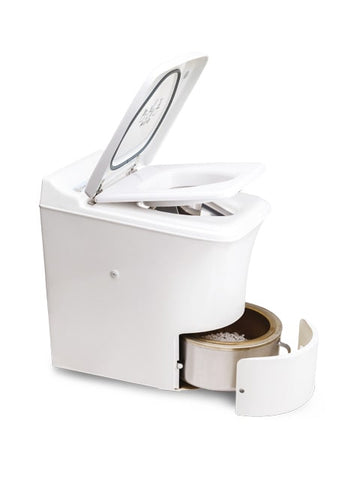
This high-temperature process eliminates pathogens and reduces the volume of waste significantly. Cinderella toilets typically operate on electricity or alternative fuel sources, and the ash residue can be safely disposed of.
Pros
- Waste Reduction: Efficient incineration process
- No Water Usage: Aligns with campervan water conservation
- Hygenic: least amount of contact with the waste
- Very easy and clean disposal
- Good for long term or high use
- Easy to clean
Cons
- Higher Initial Costs: The most expensive toilet option
- Power Dependency: Requires a power source for incineration
- Complicated bit of kit: Lots of moving parts which might need repairing long term
- Comfort Level: Some users may be uneasy with the incineration process
Portable Cassette Toilets
In addition to the mentioned options, portable cassette toilets are worth considering for their simplicity and convenience. Ideal for a campervan conversion design without a designated bathroom area. These can be stored in a cupboard etc. Often saved for emergency or night time use.

Pros
- Compact and Portable: Easy to carry and store
- User-Friendly: Simple operation
- Affordable: A very cheap option
- Easy Maintenance: Simple to empty and clean
- Water Independence: No need for a permanent water connection
- Size: Can fit anywhere (even a cupboard)
- No electricity required
Cons
- Limited Capacity: Frequent emptying required
- Basic Features: May lack advanced functions
- You can only empty the tank at certain disposal points
- Can be a smelly job to empty the tank
- Can be heavy to carry when full
- Not for Full-Time Use: Best suited for occasional use
- Maintenance: Regular care for the cassette tank is essential
- Uses chemicals to stop the smell - very bad for the environment
Final Thoughts
In the quest for the perfect campervan toilet, the options presented offer a range of features, each with its own set of pros and cons.
The classic Cassette Toilet, represented by Thetford, provides a portable and water-efficient solution, although its regular maintenance and chemical usage may be drawbacks.
Composting toilets, exemplified by Separate or Simploo, showcase an eco-friendly approach, transforming waste into compost, with a modern design that fits well in a motorhome bathroom.
The Clesana C1 Vacuum Toilet introduces innovation, operating without water and offering hygienic, compressed waste disposal.
Cinderella's Incinerator Toilet impresses with waste reduction and minimal water usage, but its complexity and higher costs may be deterrents.
Lastly, portable cassette toilets serve as a convenient, no-frills option, ideal for emergency or occasional use in a campervan without a dedicated bathroom space.
While there may not be a one-size-fits-all solution, understanding the unique advantages and trade-offs of each toilet type is key to finding the best fit for your campervan lifestyle.




